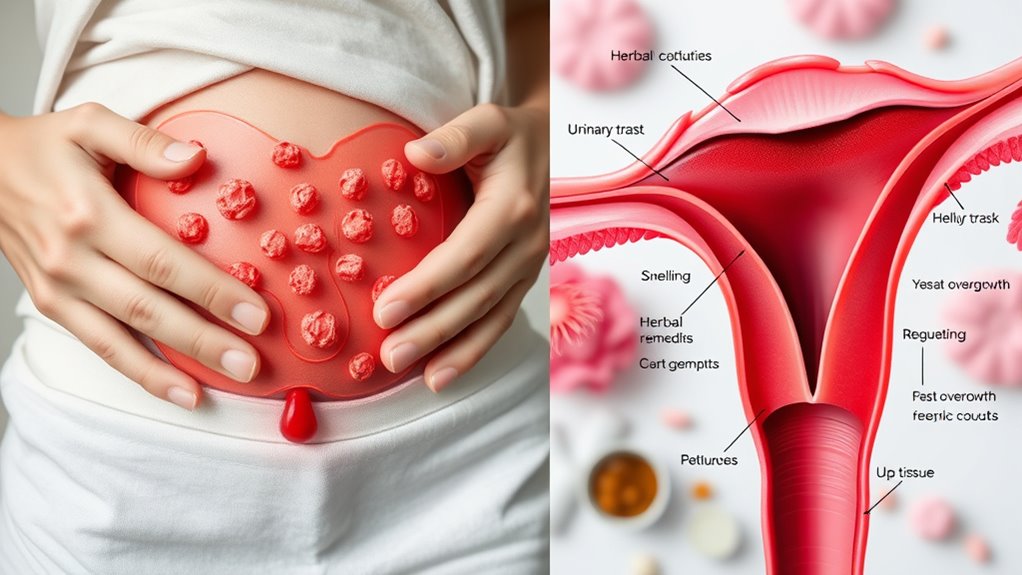To tell if you have a UTI or vaginitis, pay attention to your symptoms. UTIs usually cause burning during urination, frequent urges, and cloudy or foul-smelling urine. Vaginitis often causes itching, soreness, and abnormal vaginal discharge, which can be thick or foul-smelling. Discharge and vaginal discomfort help differentiate them. Understanding their causes, symptoms, and tests can guide you to the right treatment—if you want to learn more, keep exploring these differences.
Key Takeaways
- UTIs cause burning urination, urgency, and cloudy or foul-smelling urine, whereas vaginitis presents with vaginal itching, soreness, and abnormal discharge.
- Discharge is minimal in UTIs but noticeable and abnormal in vaginitis, often thick with yeast or gray and foul-smelling with bacterial vaginosis.
- Urinalysis detects bacteria and nitrites for UTIs; microscopic exams identify yeast or epithelial cells for vaginitis.
- UTIs typically involve urinary discomfort; vaginitis symptoms center around vaginal irritation and abnormal discharge.
- Seek medical advice if symptoms worsen, persist, or involve fever, blood in urine, or severe vaginal discomfort.
Understanding the Underlying Causes

Understanding the underlying causes of UTIs and vaginitis is essential to recognizing how these conditions develop. UTIs typically happen when bacteria, often from your skin or digestive tract, enter your urinary tract through the urethra and multiply, leading to infection. Factors like poor hygiene, sexual activity, or holding in urine too long can increase your risk. Vaginitis, on the other hand, results from an imbalance in your vaginal flora, infections like yeast or bacteria, or irritants such as soaps and spermicides. Hormonal changes, antibiotics, and certain contraceptives can also disturb the natural balance. Recognizing these causes helps you understand why these conditions occur and can guide you in preventing them. Knowing what triggers each condition is key to maintaining your reproductive health. Additionally, understanding the role of underlying health factors can help identify broader issues that may contribute to these conditions.
Recognizing Common Symptoms

Recognizing the common symptoms of UTIs and vaginitis is essential for seeking prompt treatment and relief. While symptoms can overlap, paying attention to specific signs helps distinguish between them. UTIs often cause a burning sensation during urination, frequent urges to urinate, and cloudy or foul-smelling urine. Vaginitis typically presents with itching, abnormal discharge, and discomfort or burning around the vulva. Here’s a quick comparison:
| Symptom | Likely Condition |
|---|---|
| Burning during urination | UTI |
| Itching or irritation | Vaginitis |
| Cloudy or foul urine | UTI |
| Abnormal discharge | Vaginitis |
| Urinary urgency | UTI |
| Vaginal discomfort | Vaginitis |
Recognizing these signs helps you seek the right treatment quickly. Being aware of trust issues in relationships can also influence how individuals interpret symptoms and seek help, emphasizing the importance of clear communication and understanding.
Differences in Urinary Discomfort

While both UTIs and vaginitis can cause discomfort in the urinary area, they tend to produce different types of urinary sensations. With a UTI, you usually feel a burning sensation during urination, along with a persistent urge to go even when your bladder isn’t full. You might notice cloudy or foul-smelling urine, and discomfort might extend to your lower abdomen or back. In contrast, vaginitis often causes a different kind of discomfort, such as itching, soreness, or a feeling of pressure in the vaginal area. While you may experience some burning during urination, it’s typically less intense than with a UTI. The key difference is that urinary burning with vaginitis is often accompanied by other vaginal symptoms, which we’ll cover later. Additionally, vetted products for infant skin protection highlight the importance of gentle, safe ingredients when dealing with sensitive areas.
Discharge Characteristics and Vaginal Symptoms

Discharge characteristics and vaginal symptoms differ markedly between UTIs and vaginitis. With a UTI, vaginal discharge is usually minimal or absent, and discomfort is focused on urinary burning or urgency. In contrast, vaginitis often causes noticeable vaginal discharge that varies in color, consistency, and odor depending on the cause. Yeast infections typically produce thick, white, cottage cheese-like discharge, while bacterial vaginosis results in thin, grayish, foul-smelling discharge. Vaginal itching, irritation, and soreness are common in vaginitis, whereas UTIs rarely cause these symptoms directly. If you notice abnormal vaginal discharge or persistent discomfort, it’s essential to differentiate between these conditions to ensure proper treatment. Understanding these differences helps you seek the right medical care promptly. Additionally, electric dirt bikes have become popular for fun and recreation, but they are not related to the symptoms of UTIs or vaginitis.
Risk Factors and Triggers

Your daily habits and hygiene routines can influence your risk of UTIs and vaginitis, especially if you neglect proper cleaning or wear tight clothing. Medical conditions and biological factors, like hormonal changes or immune system issues, can also trigger these infections. Understanding these risk factors helps you take better steps to prevent and manage symptoms effectively. Additionally, engaging in online affairs or exposure to scandalous content can contribute to emotional stress, which may influence immune function and susceptibility to infections.
Lifestyle and Hygiene Factors
Lifestyle and hygiene habits can considerably influence the risk of developing UTIs or vaginitis. Poor hygiene, such as wiping from back to front, can transfer bacteria to your urethra, increasing UTI chances. Wearing tight, non-breathable clothing traps moisture and warmth, creating an environment for bacterial and yeast growth, which can lead to vaginitis. Using scented soaps, douches, or feminine sprays can disrupt your natural vaginal flora, making infections more likely. Holding in urine frequently or delaying bathroom visits can also raise infection risk by allowing bacteria to multiply. Additionally, not changing out of wet clothes promptly or engaging in frequent sexual activity without proper hygiene can contribute to both UTIs and vaginitis. Maintaining good hygiene and wearing breathable fabrics help lower your risk.
Medical and Biological Triggers
Medical and biological factors can markedly increase your risk of developing UTIs or vaginitis. For instance, hormonal changes during pregnancy or menopause can alter the vaginal flora, making infections more likely. Certain medical conditions like diabetes weaken your immune system, making it harder to fight off bacteria and fungi. A suppressed immune response from medications or illnesses also heightens your vulnerability. Anatomical factors, such as a shorter urethra in women, facilitate bacterial entry, increasing UTI risk. Additionally, having a history of frequent infections or recurrent episodes can make you more prone over time. Genetic predispositions may influence your immune response or vaginal environment, affecting susceptibility. Recognizing these biological triggers helps you understand why some women are more prone and guides preventive strategies. Understanding the role of Borderline Syndrom in immune regulation can also shed light on individual susceptibility to infections.
Diagnostic Approaches and Tests

To determine whether you have a UTI or vaginitis, your healthcare provider will start with simple tests like urinalysis and dipstick analysis. They may also examine your urine under a microscope or order cultures to identify the exact bacteria or fungi involved. Sensitivity testing can then guide effective treatment by showing which antibiotics or medications will work best.
Urinalysis and Dipstick Tests
Have you ever wondered how healthcare providers quickly differentiate between a urinary tract infection and vaginitis? Urinalysis and dipstick tests are key tools in this process. When you provide a urine sample, these tests check for signs of infection, such as the presence of bacteria, white blood cells, or nitrites. They also measure urine pH and detect blood or protein, which can indicate other issues. A positive nitrite test often points to bacteria causing a UTI, while the absence of specific findings may suggest vaginitis. Dipstick tests are quick and non-invasive, helping providers decide whether an infection is likely. However, they’re not definitive alone, so additional testing may be needed for a precise diagnosis.
Microscopic Examination Techniques
Microscopic examination techniques provide a more detailed assessment of urine samples, helping distinguish between UTIs and vaginitis. By examining urine under a microscope, you can identify bacteria, white blood cells, and red blood cells, which indicate infection. The presence of bacteria and an increased number of white blood cells typically suggests a urinary tract infection. Conversely, if you see yeast, epithelial cells, or other abnormal elements, it may point toward vaginitis or other vaginal conditions. You can also detect crystals or casts that offer clues about underlying issues. This method allows you to evaluate the sample quickly and accurately, guiding your diagnosis. While not definitive on its own, microscopic examination complements other tests, providing essential information to differentiate between urinary and vaginal infections. Additionally, advances in AI-powered diagnostic tools are beginning to enhance the precision of microscopic evaluations in clinical settings.
Cultures and Sensitivity Testing
Cultures and sensitivity testing are essential diagnostic tools that help identify the specific pathogens causing UTIs or vaginitis and determine the most effective treatment options. These tests involve collecting a sample—urine, vaginal swab, or discharge—and growing it in the lab to identify bacteria, fungi, or parasites. Sensitivity testing then shows which antibiotics or antifungal agents effectively target the organisms. This process guarantees you don’t take unnecessary medications and helps prevent resistance. Incorporating advanced automation technologies can also streamline the testing process, ensuring quicker and more accurate results.
When to Seek Medical Advice

You should see a healthcare provider promptly if your symptoms worsen or don’t improve after a few days of treatment. Persistent pain, fever, or chills indicate the infection may be spreading or not responding to medication. If you experience severe discomfort, blood in your urine, or unusual vaginal discharge, seek medical help immediately. Also, contact your provider if you notice symptoms beyond the urinary or vaginal area, such as lower abdominal pain or back pain. Prompt medical attention is essential to prevent complications. Regularly monitoring your symptoms can help identify sound healing science techniques that may assist in overall recovery.
Frequently Asked Questions
Can UTIS and Vaginitis Occur Simultaneously?
Yes, you can have a UTI and vaginitis at the same time. Both conditions involve your reproductive or urinary systems and can share symptoms like discomfort or unusual discharge. If you notice symptoms like burning during urination, pelvic pain, or abnormal discharge, it’s important to see a healthcare provider. They can diagnose both issues accurately and recommend appropriate treatment to help you feel better faster.
Are There Any Home Remedies for UTIS or Vaginitis?
If you’re looking for home remedies for UTIs or vaginitis, some options might help ease discomfort. Drinking plenty of water flushes bacteria, and over-the-counter pain relievers can reduce pain. For vaginitis, probiotics or yogurt may restore healthy bacteria. However, if symptoms persist or worsen, you should see a healthcare provider for proper diagnosis and treatment, as home remedies alone might not be enough.
How Long Does It Typically Take to Recover?
Wondering how long it takes to bounce back? Well, it depends on what’s bothering you. For UTIs, antibiotics usually clear things up in a few days, often within 48-72 hours. Vaginitis recovery varies—sometimes a quick fix with treatment, other times a longer journey if it’s caused by imbalance or infection. So, patience and proper treatment are your best friends, even if it feels like waiting forever!
Are There Long-Term Health Risks From Untreated UTIS or Vaginitis?
You might wonder if untreated UTIs or vaginitis pose long-term risks. If you ignore a UTI, it can lead to serious complications like kidney infections or permanent damage. Untreated vaginitis usually isn’t as severe but can cause ongoing discomfort and increase the risk of infections. It’s best to seek treatment promptly to avoid complications, as both conditions can become more serious if left untreated.
Can Sexual Activity Worsen or Cause These Conditions?
Sexual activity can indeed worsen or trigger these conditions. It may introduce bacteria into your urinary tract, increasing the risk of a UTI, or cause irritation that leads to vaginitis. To minimize this, practice good hygiene, pee before and after sex, and use protection. If you notice symptoms worsening after intimacy, consult your healthcare provider to determine the cause and get appropriate treatment.
Conclusion
Just like a lighthouse guides ships safely to shore, understanding the differences between UTIs and vaginitis helps you navigate your health confidently. Recognize warning signs early, trust your instincts, and seek help when needed. Remember, ignoring discomfort is like sailing into stormy waters—dangerous and unwise. Prioritize your well-being, and don’t hesitate to reach out to a healthcare provider. Your health is your compass; let it lead you to clear, calm waters.









